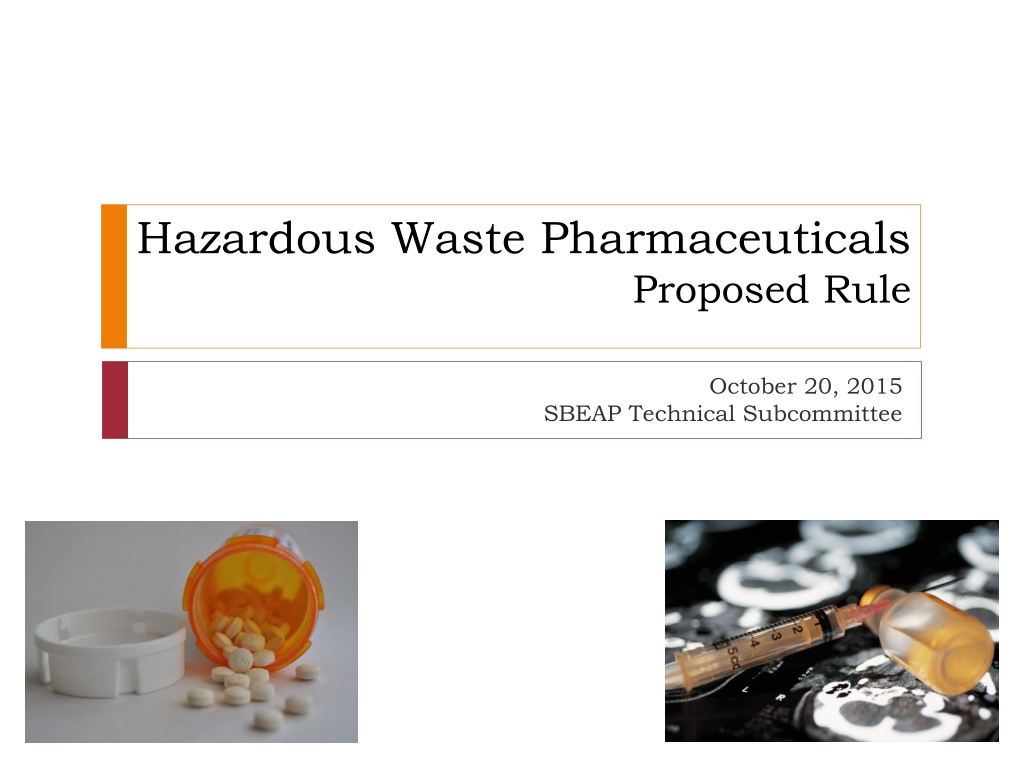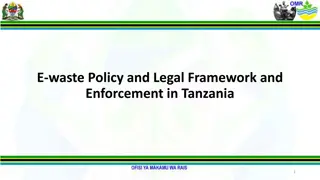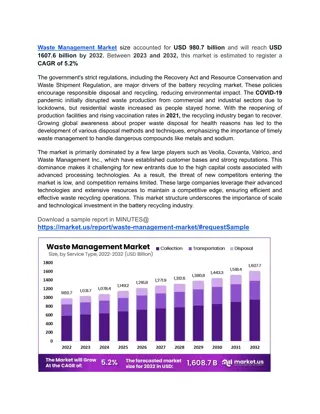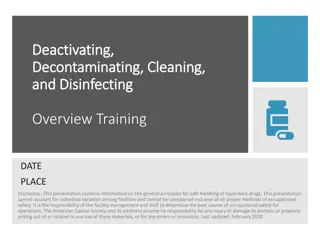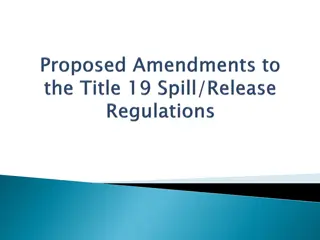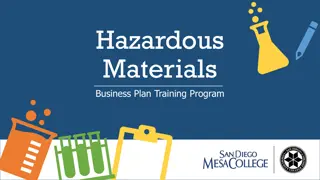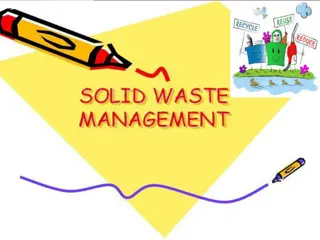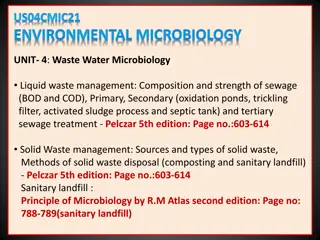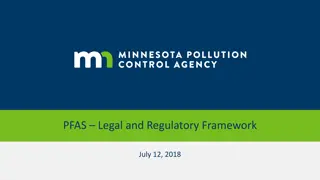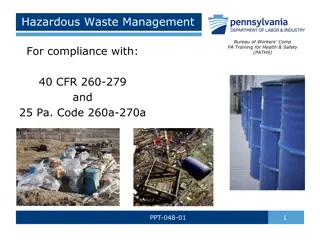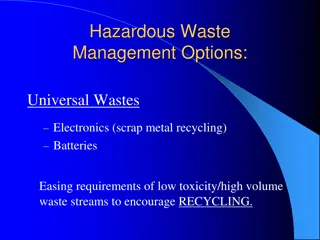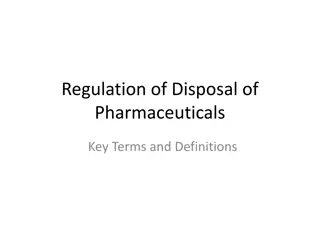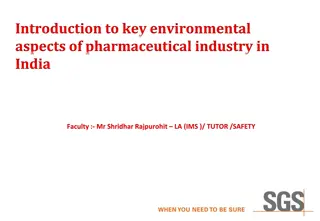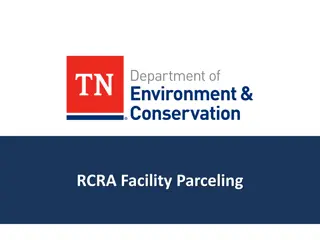Hazardous Waste Pharmaceuticals Proposed Rule Overview
This briefing provides an in-depth look at the Hazardous Waste Pharmaceuticals Proposed Rule from October 20, 2015. It covers which pharmaceuticals are considered hazardous waste, major provisions of the proposal, examples of listed hazardous waste pharmaceuticals, and the flow of hazardous waste pharmaceuticals through different entities. Key terms, standards for healthcare facilities and reverse distributors, and future steps are discussed. Various sources for identifying hazardous waste pharmaceuticals are shared along with examples of characteristic pharmaceuticals. The flow of potentially creditable pharmacy drugs, non-creditable floor waste, and the processes involving healthcare facilities, reverse distributors, and treatment storage disposal facilities are outlined.
Download Presentation

Please find below an Image/Link to download the presentation.
The content on the website is provided AS IS for your information and personal use only. It may not be sold, licensed, or shared on other websites without obtaining consent from the author. Download presentation by click this link. If you encounter any issues during the download, it is possible that the publisher has removed the file from their server.
E N D
Presentation Transcript
Hazardous Waste Pharmaceuticals Proposed Rule October 20, 2015 SBEAP Technical Subcommittee
Outline of Todays Briefing Part I: Background Which Pharmaceuticals are Hazardous Waste? Flow of Pharmaceuticals & Problem Areas Part II: Overview of Major Provisions of Proposal Defining Some Key Terms Standards for Healthcare Facilities Standards for Reverse Distributors State Adoption Part III: What s Ahead? 2
Part I: Which Pharmaceuticals are HW? There is no (free) definitive list of all pharmaceuticals that are HW A few sources to use: http://hwpharms.wikispaces.com/ http://www.hercenter.org/hazmat/pharma.cfm http://www.hercenter.org/hazmat/tenstepblueprint.pdf https://www.colorado.gov/pacific/sites/default/files/HM_mw- examples-of-hw-pharmaceuticals.pdf http://www.dep.state.fl.us/waste/quick_topics/publications/shw/h azardous/WastePharmListLetter12_07.pdf 3
Examples of Listed HW Pharmaceuticals P-Listed hazardous ACUTE wastes Warfarin (P001) Arsenic Trioxide (P012) Nicotine (P075) Physostigmine salicylate (P188) Physostigmine (P204) U-listed hazardous wastes Mitomycin C (U010) Chloral hydrate (U034) Cyclophosphamide (U058) Lindane (U129) Selenium sulfide (U205) 4
Examples of Characteristic Pharmaceuticals Ignitable (D001): Preparations with >24% alcohol Toxicity (D004-D043): if present above certain concentrations in the leachate during TCLP test Chromium (multi-vitamins) m-Cresol (preservative in insulin) Mercury (preservative thimerosal) Selenium (multi-vitamins) Silver (burn creams) 5
Part I: Flow of HW Pharmaceuticals Potentially Creditable Pharmacy Drugs 1st Reverse Distributor Healthcare Facility/ Pharmacy HW TSDF 2nd Reverse Distributor 6
Flow of HW Pharmaceuticals Potentially Creditable Pharmacy Drugs Non-creditable Floor Waste & Pharmacy Drugs 1st Reverse Distributor Healthcare Facility/ Pharmacy HW TSDF 2nd Reverse Distributor 7
Flow of HW Pharmaceuticals Potentially Creditable Pharmacy Drugs Non-creditable Floor Waste & Pharmacy Drugs 1st Reverse Distributor Healthcare Facility/ Pharmacy HW TSDF Non-Compliant Disposal Sewer 2nd Reverse Distributor 8
3 Problem Areas to Address in Rule Potentially Creditable Pharmacy Drugs Non-creditable Floor Waste & Pharmacy Drugs 1st RD Healthcare Facility/ Pharmacy HW TSDF Non-Compliant Disposal Sewer 2nd RD 9
Why a Pharmaceuticals Rulemaking? We have issued clarifying guidance where possible and within the confines of the current regulations Remaining issues require regulatory fixes via rulemaking 10
6 Main Remaining Issues for Rulemaking Regulatory status of creditable pharmaceuticals LQG status due to P-listed hazardous waste Warfarin & nicotine Manufacturing-oriented framework of the generator regulations Intersection of EPA & DEA regulations Containers with P-listed pharmaceutical residues Pharmaceuticals being flushed/sewered 1. 2. 3. 4. 5. 6. 11
Part II: Overview of Proposed Rule Proposed to add hazardous waste pharmaceuticals to the Universal Waste program (2008) Commenters felt UW was inadequate for pharmaceuticals Could not address negative comments on proposal without re- proposing New approach has been to build on the 2008 Universal Waste (UW) proposal by: Keeping the aspects of the UW proposal that commenters liked Addressing commenters concerns about the UW proposal Addressing new areas that the UW proposal did not Coordinating with other federal agencies (e.g., DEA) Promoting national consistency 12
TRUE or FALSE? The proposed rule will establish an extended producer responsibility (EPR) program 13
Which Pharmaceuticals Will be Covered? Only those pharmaceuticals that are already considered hazardous waste will be covered by the new rule This rule does NOT propose to expand the number of pharmaceuticals that are considered hazardous waste This rule proposes to change HOW the hazardous waste pharmaceuticals must be managed We encourage healthcare facilities to manage all waste pharmaceuticals under the new rule 14
Who Will be Covered by the Rule? Healthcare facilities - except CESQGs The proposed definition of Healthcare facility is: any person that (1) provides preventative, diagnostic, therapeutic, rehabilitative, maintenance or palliative care, and counseling, service, assessment or procedure with respect to the physical or mental condition, or functional status, of a human or animal or that affects the structure or function of the human or animal body; or (2) sells or dispenses over-the-counter or prescription pharmaceuticals. 15
Who Will be Covered by the Rule? All pharmaceutical reverse distributors - regardless of current generator category The proposed definition of Pharmaceutical Reverse Distributor is Any person that receives and accumulates potentially creditable hazardous waste pharmaceuticals for the purpose of facilitating or verifying manufacturer s credit Any person, including forward distributors and pharmaceutical manufacturers, that processes pharmaceuticals for the facilitation or verification of manufacturer s credit is considered a pharmaceutical reverse distributor Some drug manufacturers may operate as pharmaceutical reverse distributors 16
Problem Area #1 Potentially Creditable Pharmacy Drugs (20%) Non-creditable Floor Waste & Pharmacy Drugs (80%) 1st RD HCF HW TSDF Non-Compliant Disposal Sewer 20% 2nd RD 17
6 Main Remaining Issues for Rulemaking Regulatory status of creditable pharmaceuticals Manufacturing-oriented framework of the generator regulations LQG status due to P-listed hazardous waste Warfarin & nicotine Intersection of EPA & DEA regulations Containers with P-listed pharmaceutical residues Pharmaceuticals being flushed/sewered 1. 2. 3. 4. 5. 6. 18
#6: Sewering Pharmaceuticals Problem Flushing of pharmaceuticals has become a commonly used disposal method by healthcare facilities which Contributes to pharmaceuticals in surface and drinking water, Has the potential to present risks to human health and the environment Are not being treated for by POTWs, except incidentally Flushing is allowed by current regulation There s not some sort of magic process that can remove everything we put down the drain David Sedlak, Director of the Institute for Environmental Science and Engineering at UC Berkeley 19
#6: Sewering Pharmaceuticals Proposed Solution Rule bans the sewering of HW pharmaceuticals Sewer ban applies to all healthcare facilities & RDs, including CESQGs Otherwise CESQG healthcare facilities are not subject to the proposal Prevents 6400 TONS of hazardous waste pharmaceuticals from contaminating the water per year Sewer ban reinforces and highlights EPA s policy against flushing pharmaceuticals DEA no longer allows sewering as a means of destroying controlled substances Several federal agencies, including EPA, have been coordinating to educate consumers to stop flushing pharmaceuticals EPA would join other jurisdictions with sewer bans for pharmaceuticals, including IL, NJ, DC and CT (proposed) 20
Problem Area #2 Potentially Creditable Pharmacy Drugs (20%) Non-creditable Floor Waste & Pharmacy Drugs (80%) 1st RD HCF HW TSDF Non-Compliant Disposal 40-50% Sewer 2nd RD 21
6 Main Remaining Issues for Rulemaking Regulatory status of creditable pharmaceuticals LQG status due to P-listed hazardous waste Warfarin & nicotine Manufacturing-oriented framework of the generator regulations Intersection of EPA & DEA regulations Containers with P-listed pharmaceutical residues Pharmaceuticals being flushed/sewered 1. 2. 3. 4. 5. 6. 22
#5: Containers with Residues Problem If residues are acute/P-listed HW, then to be considered RCRA empty, containers must be: Triple-rinsed, or Cleaned by another method shown in the scientific literature or by tests by generator, to achieve equivalent removal Current RCRA empty container rules apply to residues in very small containers used in healthcare setting, including: Vials Dixie cups Souffl cups Blister packs, etc. 23
#5: Containers with Residues Proposed Solution 1. Residues in unit-dose containers and dispensing bottles/vials would be exempt from RCRA Unit-dose containers (e.g., packets, cups, wrappers, blister packs and unit-dose delivery devices) and Dispensing bottles and vials up to 1 liter or 1000 pills 2. Dispensed syringes would be exempt from RCRA provided: The syringe has been used to administer the pharmaceutical to a patient, and The syringe is placed in a sharps containers that is managed appropriately 3. All other containers, including delivery devices, that once held listed or characteristic pharmaceuticals, must be managed as hazardous waste, including IV bags, aerosols, nebulizers, etc. 24
#4: Intersection of DEA & EPA Rules Problem There are a few RCRA hazardous wastes that are also DEA controlled substances Chloral hydrate (U034) Fentanyl sublingual spray (D001) Phenobarbital (D001) Testosterone gels (D001) Valium injectable (D001) These are dually regulated by EPA and DEA must comply with both sets of regulations 25
#4: Intersection of DEA & EPA Rules Proposed Solution Two Conditional Exemptions: 1. Hazardous waste pharmaceuticals that are also DEA controlled substances would be exempt from RCRA regulation Conditions for exemption: Must be managed in accordance with all DEA regulations Must be combusted at a permitted/interim status: municipal solid waste combustor or hazardous waste combustor 26
#4: Intersection of DEA & EPA Rules Proposed Solution Two Conditional Exemptions (continued): 2. Authorized collectors of DEA controlled substances that co-mingle them with pharmaceuticals that are exempt household hazardous waste (HHW) would be exempt from RCRA regulation Conditions for exemption: Must be managed in accordance with all DEA regulations Must be combusted at a permitted/interim status: municipal solid waste combustor or hazardous waste combustor 27
#3: Manufacturing Framework Problem Healthcare facilities that generate hazardous waste are currently regulated the same as any industrial facility that generates hazardous waste Healthcare facilities differ from industry Healthcare workers and pharmacists have little expertise with RCRA yet are critical in getting the hazardous wastes directed to proper waste management Thousands of drugs in their formularies, which vary over time Lots of healthcare workers involved in generation of waste in lots of locations throughout facility Hazardous waste pharmaceuticals are unique among hazardous wastes: Street value Potential for diversion/theft 28
#3: Manufacturing Framework Proposed Solution Part 262 generator regulations are replaced by sector- specific management standards for the management of hazardous waste pharmaceuticals at healthcare facilities and pharmaceutical reverse distributors The Part 262 generator regulations do not apply to hazardous waste pharmaceuticals, including: SQG and LQG generator categories Satellite accumulation area (SAA) regulations Central accumulation area (CAA) regulations 29
#3: Manufacturing Framework Proposed Solution Accumulation on-site at healthcare facility: One-time notification as HCF (as opposed to as a generator) Performance-based training for healthcare workers Potentially Creditable HW pharmaceuticals No specific labeling or accumulation time limits proposed Non-creditable HW pharmaceuticals Similar to simplified Universal Waste standards One year accumulation before a permit is required Closed containers secured to prevent access to contents Wastes that can t be incinerated must be accumulated separately (e.g., P012) HW codes are not required on accumulation containers Label as Hazardous Waste Pharmaceuticals 30
#3: Manufacturing Framework Proposed Solution Shipments off-site from a healthcare facility: Potentially Creditable HW pharmaceuticals can go to a Pharmaceutical Reverse Distributor: Written, advance notice of shipments to RD Confirmation of receipt of shipment by RD Recordkeeping of shipments to RD Common carrier allowed HW codes not required during shipment Non-creditable HW pharmaceuticals must go to a TSDF HW transporter required Manifesting required HW codes not required on manifest Hazardous waste pharmaceuticals in Box 14 of manifest 31
#2: LQG Status Due to Acute HW Problem LQG status for healthcare facilities & pharmacies due to exceeding 1 kg acute HW/month, which results in: Shorter accumulation time Biennial Reporting More training requirements and documentation Higher costs for generators Higher costs for states who must inspect LQGs more frequently 32
#2: LQG Status Due to Acute HW Proposed Solution HW pharmaceuticals do not have to be counted toward the healthcare facility s generator status when they are managed under Part 266 Subpart P No SQG or LQG status for HW pharmaceuticals All HW pharmaceuticals are managed the same Don t have to keep track of monthly generation for hazardous waste pharmaceuticals Don t have to accumulate acutes and non-acutes separately Reduces incidences of episodic generation Removes regulatory disincentive for managing non-hazardous pharmaceuticals as hazardous pharmaceuticals 33
Problem Area #3 Potentially Creditable Pharmacy Drugs (20%) Non-creditable Floor Waste & Pharmacy Drugs (80%) 1st RD HCF HW TSDF Non-Compliant Disposal Sewer 2nd RD 34
6 Main Remaining Issues for Rulemaking Regulatory status of creditable pharmaceuticals LQG status due to P-listed hazardous waste Warfarin & nicotine Manufacturing-oriented framework of the generator regulations Intersection of EPA & DEA regulations Containers with P-listed pharmaceutical residues Pharmaceuticals being flushed/sewered 1. 2. 3. 4. 5. 6. 35
#1: Status of Creditable Pharmaceuticals Problem Current guidance allows point of generation of creditable pharmaceuticals to be at reverse distributor, based on the assumption that some pharmaceuticals will be redistributed Creditable pharmaceuticals are not regulated as wastes even though they are being discarded after manufacturer s credit is processed by reverse distributor Current guidance creates concern about lack of tracking and the potential for diversion (theft) Some states are questioning our interpretation Regulatory uncertainty exists for reverse distributors and the healthcare facilities that use them 36
TRUE or FALSE? EPA will not allow the redistribution of pharmaceuticals 37
#1: Status of Creditable Pharmaceuticals Proposed Solution A Pharmaceutical Reverse Distributor would be considered a new type of hazardous waste management facility Can only accept potentially creditable hazardous waste pharmaceuticals No RCRA storage permit required All RDs are regulated the same for hazardous waste pharmaceuticals No CESQG, SQG or LQG categories for hazardous waste pharmaceuticals Standards similar to LQGs, with additions: One-time notification as RD (as opposed to as a generator or TSDF) Inventory of HW pharmaceuticals Facility security 38
State Adoption On the whole, the proposed rule is considered more stringent than current policy and regulation States will be required to adopt the final rule Regulated entities will be required to use the final rule The sewer ban is considered a HSWA provision It will be effective in all states upon the effective date for the rule, even before the state adopts it Universal Waste is not considered protective enough for pharmaceuticals FL & MI will have to replace their UW programs with this one 39
Part III: Whats Ahead? Publication of proposed rule in Federal Register Administrator signed the proposed rule August 31, 2015 Published in FR: September 25, 2015; 80 FR 58014 60-day public comment period Public comment period ends Tuesday, November 24, 2015 EPA has received multiple requests for extension EPA reviews public comments & commences work on final rule EPA decides whether to proceed on additional proposed or final rules related to: Expanding what pharmaceuticals are hazardous Nicotine 40
